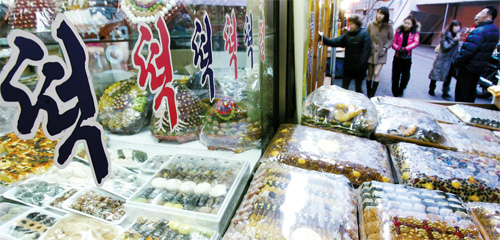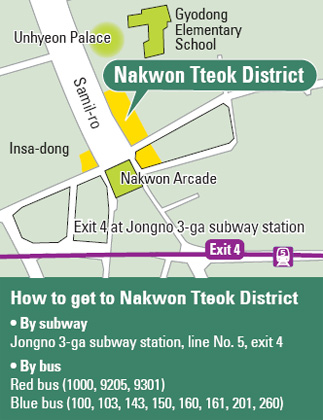Traditional Korean rice cakes take a pounding in the streets of Nakwon

Baskets and plastic packs full of tteok, Korean traditional rice cakes, at a store in Nakwon-dong.By Jeon Min-kyu
Also dispersed in Nakwon-dong are beer bars, singing rooms and hole-in-the-wall Korean restaurants serving up angler and freshwater eel, mostly housed in buildings that appear to be over 30 years old, and Nakwon Instrument Complex.
During the 1970s there used to be around 50 tteok stores in the district but as the area underwent refurbishment, the figure gradually reduced, according to shop owners there. More tteok stores can be found in a multitude of alleys leading deeper into the Insa-dong area.
The Nakwon Tteok District dates back to the 1910s, when Korea was under Japanese colonial rule, according to Lee Gwang-soon, owner of Nakwon Tteokjip. Women from the court who had nowhere to go after the Joseon Dynasty lost its sovereignty to Japan started selling tteok.

Lee, in her mid 60s, is the third-generation owner of the tteok house. She inherited the shop from her mother, who took over the initial business from her own mother.
“My mother named this shop after the district name Nakwon-dong after the Korean War ended in the 1950s,” she said. Although she claims her shop to be the “original,” the number of Nakwon Tteokjip across the country number in the tens, probably affected by the name of the district. Simply googling the name in Korean retrieves dozens of different domains. Among them is the Nakwon Tteokjip in Los Angeles’ Koreatown. Other tteok shops such as Jeil, Pyeongwha, Nammun and Jongno are all within a few steps of Nakwon and they are mostly at least 40 years old. An old lady in her late 70s runs Nammun Tteokjip, which she has been operating with her husband for the past several decades. Sitting alone near a stack of rice bags in her small shop, she was slicing and dicing dried pumpkin for use in tteok when an old man in a felt hat came in and picked up two packs of jeungpyeon, which is made of sticky rice powder, sugar and makgeolli, or brewed rice wine.
The man, who declined to give his name said, “I drop by here to buy some tteok whenever I go over to Tapgol Park nearby.” Tapgol Park, established in 1897, is an oasis for senior citizens in Seoul.
Sticky rice, or chapssal, is a basic ingredient for tteok, just as flour is the key ingredient for pizza or cakes.
But the traditional Korean snack, or a breakfast staple for some folks, has more than 200 varieties, depending on the accompanying ingredients.
The ingredients could be other grains, fruits and vegetables. Their garnishes range from a variety of herbs to flowers. They are mostly steamed after the sticky rice is pounded into powder and kneaded or molded.
A typical store produces up to 50 kinds of tteok.
Tteok has been a quintessential dish that Koreans enjoy on any occasion - birthday parties including the first, 60th, 70th and beyond, ancestral rites and business-launching events.
Most tteok shops also prepare food for wedding ceremonies that require highly refined craftsmanship.
Those foods include layers of dates and chestnuts adorned with pine nuts and silk threads, elaborately carved half-dried squid that looks like flowers, beef jerky marinated with soy sauce and honey and sugar-soaked ginseng.
However, the demand for foods specially prepared for weddings, which accounted for a large slice of tteok stores’ revenue, is on the downturn as people increasingly opt for a low-budget ceremony because of the financial debacle.
“A lot of couples today skip pyebaek and ibaji [foods for the pre- and post-wedding ceremonies] under mutual agreement. The trend is dealing an immense blow to our sales revenues,” said the owner of Pyeongyang Tteokjip.
Also eroding sales at Nakwon-dong tteok stores is the emergence of Internet-based shops. Kim Joon-hee, a pianist living in western Seoul, used to place hundreds of orders for assorted tteok from a shop in Nakwon to give to her recital attendees as a gift. Now she orders over the Internet from a shop located in Gyeonggi Province. Because Kim can browse and buy gift sets on the Web, the distance poses no problem.
“When I can order tteok gifts at moderate prices without having to visit the shop, why would I take the hassle of going all the way to the central Seoul?” she said.
Still, Nakwon’s shops seem to take pride in adhering to traditional methods of promotion and sales. Only two - Nakwon and Jeil - operate a Web site. Although it’s been hard to make ends meet lately due to a conspicuously smaller number of visitors, the owner of Pyeongyang Tteokjip said patrons from other parts of Seoul keep coming.
“We make it a rule to use the best-quality rice and sesame oil grown in Korea, not from foreign countries. With that rule, we have built up a good relationship with long-term customers,” she said.
Major customers include companies and small shops nearby, which order a hefty volume of tteok when celebrating completion of a corporate project or launching a business.
“As Jongno District accommodates a number of jewelers’ shops, we get a big order whenever a new one opens,” the shop owner added.
Sometimes the Blue House and large conglomerates come to buy tteok for important occasions, said Lee of Nakwon Ttteokjip.
By Seo Ji-eun Staff Reporter [spring@joongang.co.kr]










with the Korea JoongAng Daily
To write comments, please log in to one of the accounts.
Standards Board Policy (0/250자)